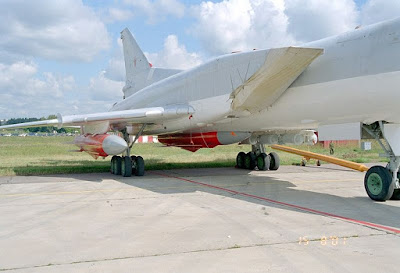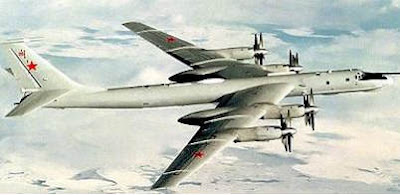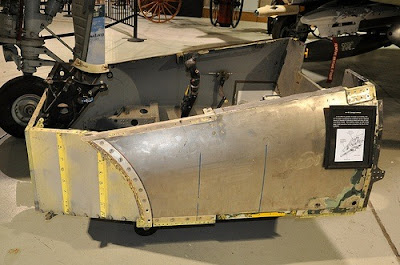I will roll with 2 staples of the Soviet Naval Aviation, the "Backfire" and the "Bear", the Soviets in the book based the Backfire around 4 bases around the city of Kirovsk on the Kola Peninsula to strike the NATO convoys supplying the Allied armies defending Germany against the Soviet attack. The first mission of the Backfires was the deception and attack on the Task Force heading to Iceland to reinforce the Icelandic garrison. The Backfires launched Kelt missiles that mimiced the Backfires from a different direction and after leading the Tomcats away from the Nimitz, they came at a different direction and attacked the fleet with RADUGA KSR-5 series of missiles, the Nimitz was damaged, the USS SAIPAN was sunk along with the French carrier "FOCH". The battle was a shock to the Americans who expected to do better against their adversaries. The Backfire threat were neutralized later by the U.S.S Chicago and her sisters when they fired Tomahawk cruise missiles and caught the backfires as they were landing and decimated the regiments.
The Soviets used the Bears to loiter and look for the American ships either Naval or convoy to direct the Backfires to the convoys, they also had the ability to talk to the Soviet Submarines that also were attacking the convoys. The Bears were known for having long legs for such missions but were practically unarmed.
The Tupolev Tu-22M (Russian: Туполев Ту-22М; NATO reporting name: Backfire) is a supersonic, variable-sweep wing, long-range strategic and maritime strike bomber developed by the Tupolev Design Bureau. According to some sources, the bomber was believed to be designated Tu-26 at one time. During the Cold War, the Tu-22M was operated by the Soviet Air Force (VVS) in a strategic bombing role, and by the Soviet Naval Aviation (Aviacija Vojenno-Morskogo Flota, AVMF) in a long-range maritime anti-shipping role. Significant numbers remain in service with the Russian Air Force, and as of 2014 more than 100 Tu-22Ms are in use.
As in the case of its contemporaries, the MiG-23 and Su-17 projects, the advantages of variable-sweep wing (or "swing wing") seemed attractive, allowing a combination of short take-off performance, efficient cruising, and good high-speed, low-level flight. The result was a new swing wing aircraft named Samolyot 145 (Aeroplane 145), derived from the Tupolev Tu-22, with some features borrowed from the abortive Tu-98. The Tu-22M was based on the Tu-22's weapon system and used its Kh-22 missile. The Tu-22M designation was used to help get approval for the bomber within the Soviet military and government system.
The Tu-22M designation was used by the Soviet Union during the SALT II arms control negotiations, creating the impression that it was a modification of the Tu-22. Some suggested that the designation was deliberately deceptive, and intended to hide the Tu-22M's performance. Other sources suggest the "deception" was internal to make it easier to get budgets approved. According to some sources, the Backfire-B/C production variants were believed to be designated Tu-26 by Russia, although this is disputed by many others. The US State and Defense Departments have used the Tu-22M designation for the Backfire
The two prototypes Tu-22M0 were delivered to Long Range Aviation’s 42nd Combat Training Centre at Dyagilevo air base, near Ryazan, in February 1973. The aircraft began practice sorties in March. Within 20 days of the aircraft’s delivery, the air and ground crew at the air base had received their type ratings; this was helped by their earlier training at Tupolev, the Gromov Flight Research Institute and the Kazan plant. In June that year, the aircraft were demonstrated to Soviet government officials, destroying tanks and armoured personnel carriers.
The Tu-22M was first unveiled in 1980 during the aircraft’s participation in a major Warsaw Pact exercise. During the exercise, naval Tu-22M2s conducted anti-ship operations by mining parts of the Baltic Sea to simulate an amphibious landing. The exercise was extensively covered by the press and TV media. In June 1981, four Tu-22Ms were intercepted and photographed by Norwegian aircraft flying over the Norwegian Sea.
The first simulated attack by the Tu-22M against a NATO carrier group occurred between 30 September and 1 October 1982. Eight aircraft locked onto the U.S. task forces of USS Enterprise and USS Midway which were operating in the North Pacific. They came within 120 mi (200 km) of the task forces. The reaction of the U.S. Navy was thought to have been restrained during this event so as to allow the observation of the Tu-22M's tactics. The bomber also made attempts to test Japan's air defense boundary on several occasions.
The Tu-22M was first used in combat in Afghanistan. It was deployed December 1987 to January 1988, during which the aircraft flew strike missions in support of the Soviet Army's attempt to relieve the Mujahideens' siege against the city of Khost. Two squadrons of aircraft from the 185th GvBAP based at Poltava were deployed to Maryy-2 air base in Turkmenistan. Capable of dropping large tonnages of conventional ordnance, the aircraft bombed enemy forts, bases and material supplies. In October 1988, the aircraft was again deployed against the Mujahideen. Sixteen Tu-22M3s were used to provide cover to Soviet forces that were pulling out of the country. The Tu-22Ms were tasked with destroying paths of access to Soviet forces, attacking enemy forces at night to prevent regrouping, and to attack incoming supplies from Iran and Pakistan. Working alongside 30 newly arrived MiG-27s, the aircraft also from flew missions aimed at relieving the besieged city of Kandahar. The aircraft had its last Afghan operation in January 1989 at Salang pass.
The Tu-22M suffered from widespread maintenance issues during its service with the Soviet forces. These stemmed from poor manufacturing quality. The engines and airframes in particular had low service lives. The Air Force at one point sought to have Tupolev prosecuted for allegedly rushing the inadequate designs of the Tu-22M and the Tu-160 into service. This was compounded by the government bureaucracy, which hampered the provision of spare parts to allow the servicing of the Tu-22M. With some aircraft grounded for up to six months, the mission-capable rate of the aircraft in August 1991 hovered around 30–40%.
At the time of the dissolution of the Soviet Union, 370 remained in Commonwealth of Independent States service. Production ended in 1993.
The Russian Federation used the Tu-22M3 in combat in Chechnya during 1995, performing strikes near Grozny.
In August 2007, the Tu-22M and the Tu-95 began conducting long-range patrolling, for the first time since 1992.
The Russian military acknowledged the loss of a Tu-22MR recon aircraft to Georgian air defences early in the 2008 South Ossetia war. One of its crew members was captured (Major Vyacheslav Malkov), two others were killed and the crew commander, Lt. Col. Aleksandr Koventsov, was missing in action as late as November 2011
The Tupolev Tu-95 (Russian: Туполев Ту-95; NATO reporting name: "Bear") is a large, four-engine turboprop-powered strategic bomber and missile platform. First flown in 1952, the Tu-95 entered service with the Soviet Union in 1956 and is expected to serve the Russian Air Force until at least 2040. A development of the bomber for maritime patrol is designated Tu-142, while a passenger airliner derivative was called Tu-114.
The aircraft has four Kuznetsov NK-12 engines with contra-rotating propellers. It is the only propeller-powered strategic bomber still in operational use today. The Tu-95 is one of the loudest military aircraft, purportedly because the tips of the propeller blades move faster than the speed of sound Its distinctive swept-back wings are at a 35° angle. The Tu-95 is one of very few mass-produced propeller-driven aircraft with swept wings
The design bureau, led by Andrei Tupolev, designed the Soviet Union's first intercontinental bomber, the 1949 Tu-85, a scaled-up version of the Tu-4, a Boeing B-29 Superfortress copy.
A new requirement was issued to both Tupolev and Myasishchev design bureaus in 1950: the proposed bomber had to have an un-refueled range of 8,000 km (4,970 mi)—far enough to threaten key targets in the United States. Other goals included the ability to carry an 11,000 kg load over the target.
The big problem for Tupolev was the engine choice: the Tu-4 showed that piston engines were not powerful enough to fulfill that role, while the fuel-hungry AM-3 jet engines of the proposed T-4 intercontinental jet bomber did not provide adequate range. Turboprops offered more power than piston engines and better range than jets available for the new bomber's development at the time, while offering a top speed between these two alternative choices.
Tupolev's proposal was selected and Tu-95 development was officially approved by the government on 11 July 1951. It featured four Kuznetsov coupled turboprops, each fitted with two contra-rotating propellers with four blades each, producing a nominal 8,948 kW (12,000 eshp) power rating. The then-advanced engine was designed by a German team of ex-Junkers prisoner-engineers under Ferdinand Brandner. In contrast, the fuselage was conventional: a mid-wing cantilever monoplane with 35 degrees of sweep, an angle which ensured that the main wing spar passed through the fuselage in front of the bomb bay. Retractable tricycle landing gear was fitted, with all three gear strut units retracting rearwards, with the main gear units retracting rearwards into extensions of the inner engine nacelles.
Like its American counterpart, the Boeing B-52 Stratofortress, the Tu-95 has continued to operate in the Russian Air Force while several subsequent iterations of bomber design have come and gone. Part of the reason for this longevity was its suitability, like the B-52, for modification to different missions. Whereas the Tu-95 was originally intended to drop free-falling nuclear weapons, it was subsequently modified to perform a wide range of roles, such as the deployment of cruise missiles, maritime patrol (Tu-142), and even civilian airliner (Tu-114). An AWACS platform (Tu-126) was developed from the Tu-114. An icon of the Cold War, the Tu-95 has served, not only as a weapons platform, but as a symbol of Soviet and later Russian national prestige. Russia’s air force has received the first examples of a number of modernised strategic bombers Tu-95MSs following upgrade work. Enhancements have been confined to the bomber’s electronic weapons and targeting systems.
Data from Combat Aircraft since 1945
General characteristics- Crew: six–seven; pilot, co-pilot, flight engineer, communications system operator, navigator, tail gunner plus sometimes another navigator.
- Length: 46.2 m (151 ft 6 in)
- Wingspan: 50.10 m (164 ft 5 in)
- Height: 12.12 m (39 ft 9 in)
- Wing area: 310 m² (3,330 ft²)
- Empty weight: 90,000 kg (198,000 lb)
- Loaded weight: 171,000 kg (376,200 lb)
- Max. takeoff weight: 188,000 kg (414,500 lb)
- Powerplant: 4 × Kuznetsov NK-12M turboprops, 11,000 kW (14,800 shp) each
- Maximum speed: 830 km/h (516 mph)
- Range: 15,000 km (8,100 nmi, 9,400 mi) unrefueled
- Service ceiling: 13,716 m (45,000 ft)
- Rate of climb: 10 m/s (2,000 ft/min)
- Wing loading: 606 kg/m² (124 lb/ft²)
- Power/mass: 235 W/kg (0.143 hp/lb)
- Radar-controlled guns: 1 or 2 × 23 mm AM-23 autocannon in tail turret.
- Missiles: Up to 15,000 kg (33,000 lb), including the Raduga Kh-20, Kh-22, and Kh-55/101/102, or 8 Kh-101/102 cruise m





































